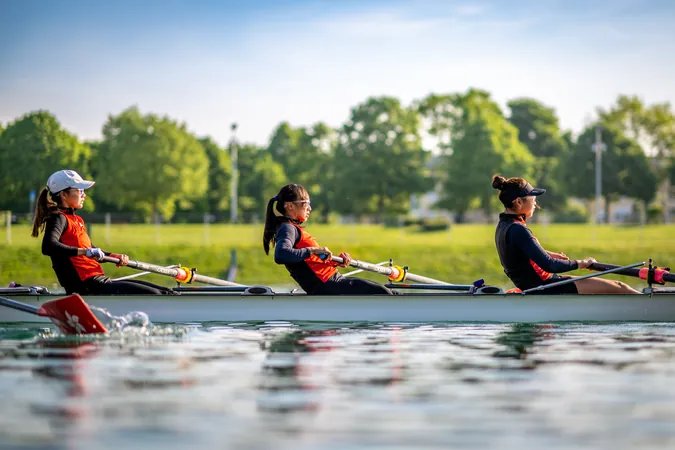
The Thriving Tide of Rowing in Hong Kong: What Lies Ahead?
2025-01-13
Author: Ying
Over the last few years, rowing in Hong Kong has experienced a thrilling transformation, witnessing a surge in both traditional and coastal rowing disciplines. This growth not only mirrors the city's athletic ambitions but also highlights its rich cultural heritage. So, what factors are driving this rise? And how can Hong Kong ensure that rowing continues to flourish?
The Historical Context of Rowing in Hong Kong
Rowing first made its way to Hong Kong during the colonial era, primarily introduced by British expatriates as a leisurely activity. The Royal Hong Kong Yacht Club, established in 1849, emerged as a focal point for both sailing and rowing. Early competitive events began in the 1900s, though participation was largely limited to an elite few.
The sport began to take a more structured form in the mid-20th century with the establishment of various rowing clubs, including the Hong Kong Yacht Club. A significant turning point came in 1968 with the foundation of the Hong Kong Rowing Association (HKRA), which standardized competition and broadened access, laying the groundwork for a competitive rowing culture. Throughout the 1970s, the sport expanded, and local regattas and training programs attracted enthusiasts from diverse backgrounds, adding to the vibrancy of Hong Kong’s rowing community.
The Rise of Coastal Rowing
Coastal rowing is carving its niche and could potentially surpass traditional flat-water rowing as the most popular form in Hong Kong. The sport’s thrilling challenges have lured renowned international athletes, such as New Zealand's Mat Dunham and Finn Hammill. Events like the Around Hong Kong Race are enjoying rising participation, emphasizing coastal rowing's adventurous spirit—a stark contrast to traditional rowing.
With advancements in equipment and facilities supported by organizations like the Hong Kong China Rowing Association (HKCRA), coastal rowing continues to gain momentum, appealing especially to young and master athletes alike.
Recent International Triumphs
Hong Kong has made waves on the global rowing stage, with notable athletes marking their place in history. Winne Hung Wing Yan famously qualified for the Tokyo Olympic Games in the women's single sculls, showcasing her formidable skills against fierce international competition. On the men's front, Chiu Hin Chun's qualification for the 2024 Paris Olympic Games—along with clinching gold in the lightweight men’s single sculls at the World Rowing Cup II in Switzerland—has been a game changer, highlighting the prowess of Hong Kong rowers.
This international acclaim has garnered attention from potential spectators and recruits alike, invigorating interest in the sport across the region.
Youth Engagement and the Role of Families
The foundation of youth engagement in rowing is significantly reinforced by family support. In a culture where discipline is essential, parents recognize the value of sports in nurturing resilience and a strong work ethic in their children.
Schools and universities are stepping up to provide platforms for aspiring rowers, enabling them to participate in competitions and develop their skills. Local rowing clubs play a pivotal role in fostering interest and cultivating talent among different age groups, thus expanding the sport's outreach.
Cultural Influences and the Future of Rowing
The shared belief in excellence prevalent throughout Asia is increasingly driving achievements in sports, especially rowing in Hong Kong. This cultural ethos encourages athletes to push the limits and aspire for excellence, breaking the notion that rowing is solely a Western sport.
As perceptions shift, more athletes are discovering rowing as a viable and rewarding path, paving the way for a broader and more inclusive sporting culture in Hong Kong and beyond.
Looking Ahead: Promising Horizons for Rowing in Hong Kong
The outlook for rowing in Hong Kong is bright, buoyed by increased funding from both government and private sectors, as well as a string of international successes. A growing talent pool will bolster Hong Kong's competitiveness in the global arena.
Youth development remains paramount, with initiatives such as school programs and youth camps already showing positive results. Expanding these grassroots initiatives will be crucial to sustaining the sport’s growth and nurturing the next generation of Hong Kong rowers.
In conclusion, as rowing continues its rise in Hong Kong, a unified approach focusing on youth engagement, international outreach, and community support will enhance the sport’s trajectory, ensuring a bright future for rowing enthusiasts in the dynamic city. Will Hong Kong become a powerhouse of rowing excellence? Only time will tell, but the waves of change are certainly promising.





 Brasil (PT)
Brasil (PT)
 Canada (EN)
Canada (EN)
 Chile (ES)
Chile (ES)
 Česko (CS)
Česko (CS)
 대한민국 (KO)
대한민국 (KO)
 España (ES)
España (ES)
 France (FR)
France (FR)
 Hong Kong (EN)
Hong Kong (EN)
 Italia (IT)
Italia (IT)
 日本 (JA)
日本 (JA)
 Magyarország (HU)
Magyarország (HU)
 Norge (NO)
Norge (NO)
 Polska (PL)
Polska (PL)
 Schweiz (DE)
Schweiz (DE)
 Singapore (EN)
Singapore (EN)
 Sverige (SV)
Sverige (SV)
 Suomi (FI)
Suomi (FI)
 Türkiye (TR)
Türkiye (TR)
 الإمارات العربية المتحدة (AR)
الإمارات العربية المتحدة (AR)